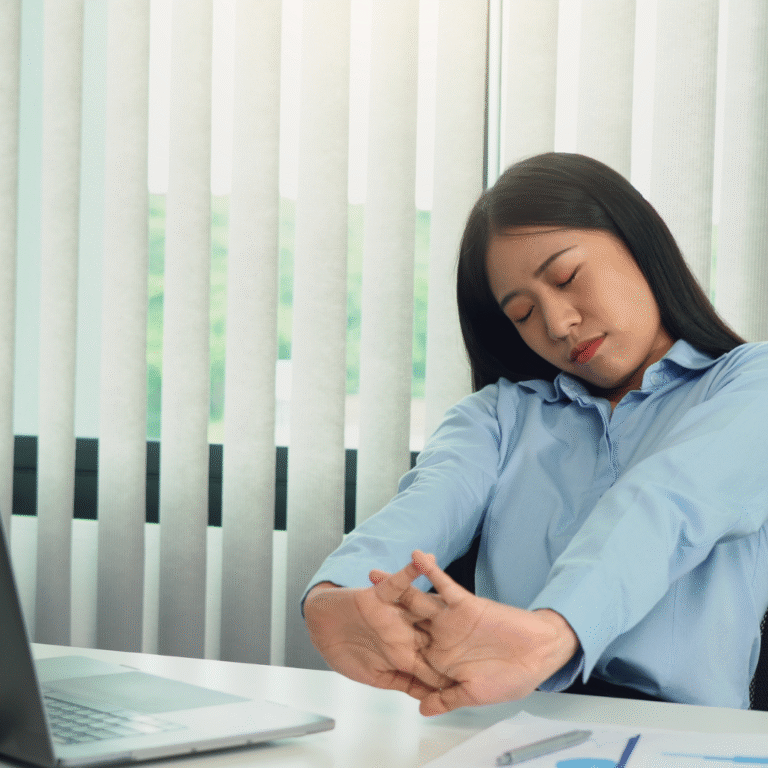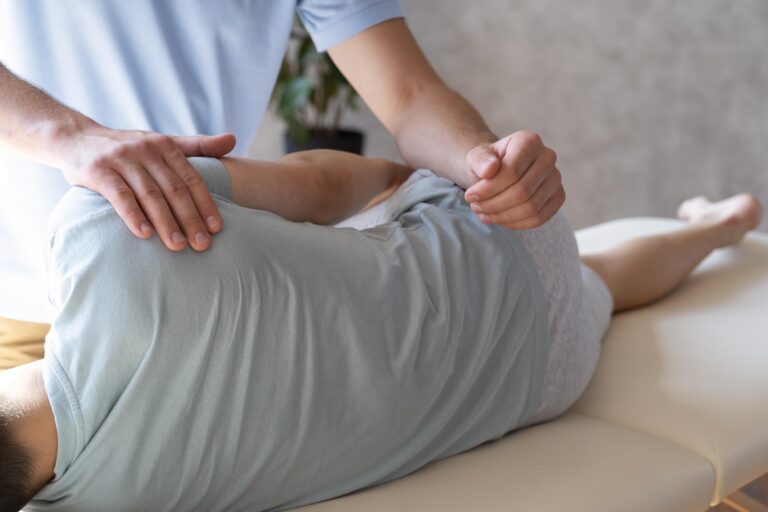Device-Related Posture Issues are becoming increasingly common in our tech-driven world. As we spend more time on our devices, the risk of developing pain and discomfort rises. In this post, we’ll explore how your devices may be affecting your posture and what you can do to prevent these issues.

Tech Neck
Looking down at your phone or tablet for long periods can strain your neck muscles, causing “tech neck.” This leads to pain, stiffness, and headaches.
Evidence: Experts explain that bending your head forward at a 45-degree angle can increase the force on your neck to nearly 50 pounds. This repetitive strain can injure the facet joints and tighten surrounding muscles, causing inflammation and pain.
Tip: Hold your device at eye level and take regular breaks to stretch your neck and shoulders.

Texting Thumb
Frequent texting or typing on small screens can cause “texting thumb” or “gamer’s thumb,” leading to pain and inflammation in your thumbs.
Evidence: Hand surgeons have noted an increase in thumb discomfort linked to smartphone use. Repetitive thumb motions can lead to conditions like trigger thumb and De Quervain’s tenosynovitis, causing pain and difficulty moving the thumb.
Tip: Use voice-to-text features, take breaks, and perform thumb stretching exercises to reduce strain.

Wrist strain
Using a laptop or mouse for extended periods can strain your wrists and lead to conditions like carpal tunnel syndrome.
Evidence: Repetitive strain from device use can lead to wrist pain and other issues due to muscle stiffness and joint inflammation. Ergonomic tools and regular breaks can help mitigate these effects.
Tip: Maintain a neutral wrist position, use ergonomic keyboards and mouse pads, and stretch your wrists frequently.
Back Pain
Sitting for long periods while using your devices can lead to poor posture and back pain.
Evidence: Research indicates that prolonged sitting and poor posture while using devices can lead to lower back pain and increased pressure on the spine. Studies in BMC Musculoskeletal Disorders highlight the association between prolonged sitting and back pain.
Tip: Set up an ergonomic workspace with a supportive chair and practice good posture. Stand up and move around every hour to reduce back strain.
Eye Strain
Staring at screens for prolonged periods can cause eye strain, dryness, and discomfort.
Evidence: Extended screen time is linked to digital eye strain, including symptoms like dry eyes and headaches. Adopting proper screen habits can alleviate these issues.
Tip: Follow the 20-20-20 rule: every 20 minutes, look at something 20 feet away for at least 20 seconds. Adjust your screen brightness and reduce glare.
While devices are essential in modern life, it’s important to be aware of their impact on your health. By making small adjustments to how you use your devices, you can reduce pain and improve your well-being.
Don’t let tech pain hold you back! Contact us today for personalized advice and treatments to help you stay pain-free in our digital world.
References:
- Trivedi, K. (2023). “All that texting and scrolling leads to a rise in ‘tech neck’.” UT Southwestern Medical Center. Retrieved from UT Southwestern (Home) (MedXpress).
- Woo, E. H. C., White, P., & Lai, C. W. K. (2016). “Impact of information and communication technology on health and well-being of children and adolescents.” Journal of Physical Therapy Science. Retrieved from JPTS (UK HealthCare).
- Hansraj, K. K. (2014). “Assessment of stresses in the cervical spine caused by posture and position of the head.” Surgical Technology International, 25, 277-279. Retrieved from NCBI (MedXpress).
- Hinge Health. (2023). “Texting Thumb: Tips and Exercises to Relieve the Pain.” Retrieved from Hinge Health (hingehealth).
- UK HealthCare. (2023). “Texting thumb is real, but there are ways to find relief.” Retrieved from UK HealthCare (UK HealthCare).
- Orthopedic Specialists of Seattle. (2023). “The 21st Century Thumb – Texting Can Lead to Thumb Arthritis.” Retrieved from Orthopedic Specialists of Seattle (Orthopedic Specialists of Seattle).





